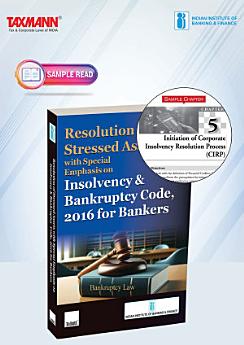IIBF X Taxmann's Resolution of Stressed Assets with Special Emphasis on Insolvency & Bankruptcy Code 2016 for Bankers – Incorporating Practical Procedures & Structured Learning Tools
About this ebook
This book is intended for the following audience:
• Bankers & Finance Professionals – Frontline managers, credit officers, and decision-makers who handle corporate and non-corporate loan portfolios and seek to prevent or address Non-Performing Assets (NPAs)
• Legal Practitioners & Insolvency Professionals – Advocates, insolvency professionals, and consultants requiring an updated reference on the IBC, its interpretations, and procedural intricacies
• Corporate Executives & Entrepreneurs – Company directors, CFOs, and entrepreneurs who may be involved in insolvency proceedings or wish to understand the preventive mechanisms of stressed asset management
• Academics & Students – Researchers, faculty members, and students of finance, law, and management programs looking for a structured and practice-oriented insight into India's insolvency framework
The Present Publication is the 2025 Edition, authored by M.R. Umarji (former Executive Director – RBI & former Chief Advisor – Legal | IBA). It is updated by CA. S. Badri Narayanan (CS, LL.B., M.Com.) and vetted Prasad Barje (Former Director – State Bank Institute of Learning & Development, Pune). Taxmann exclusively publishes this book for the Indian Institute of Banking and Finance with the following noteworthy features:
• [Comprehensive Coverage] Spans from foundational credit recovery laws (RDDB & FI Act, SARFAESI) to the contemporary insolvency and bankruptcy processes for corporate and non-corporate entities
• [Updated Content] Incorporates the latest amendments, circulars (including RBI's Prudential Framework for Resolution of Stressed Assets), and important case laws relevant to stressed asset resolution
• [Practical Insights] Offers detailed insights into practical applications—case studies, step-by-step procedures for initiating CIRP, Fast Track CIRP, and Pre-Packaged Insolvency Resolution Process
• [Expert Guidance] Reviewed by former senior bankers and updated by an insolvency specialist, ensuring reliability and practicality for banking professionals
• [Structured Learning Aids] Includes module-wise chapters, 'Check Your Progress' sections, and keywords to facilitate self-paced learning and conceptual clarity
• [Easy Reference] Contains templates and formats for applications to Adjudicating Authorities (NCLT/DRT), alongside curated appendices such as RBI circulars and regulations
The detailed coverage of this book is as follows:
• Module A – Overview of Credit Recovery and Insolvency Laws
o Historic evolution and challenges in India's credit recovery framework
o SARFAESI, RDDB & FI Act, Commercial Courts, and how they relate to the IBC
• Module B – Evolution & Practice of Insolvency and Bankruptcy Code
o Genesis of the IBC and the Insolvency and Bankruptcy Board of India (IBBI)
o Cross-country comparisons and bankruptcy laws abroad
o Overview of IBC structure and how it transformed credit discipline
• Module C – Corporate Insolvency Resolution Process (CIRP)
o Initiation of CIRP by financial creditors, operational creditors, and corporate debtors
o Roles, responsibilities, and powers of the IRP and Resolution Professional
o Committee of Creditors (CoC) dynamics, evaluation of resolution plans, Fast Track CIRP, and Pre-Packaged Insolvency (PPIRP)
• Module D – Insolvency Resolution for Individuals and Partnership Firms
o Procedural steps for individual insolvency, fresh start mechanism, and the repayment plan
o Bankruptcy proceedings against individuals and partnership firms
• Module E – Other Important Provisions/Matters
o Adjudication mechanisms, appeals, offences, and penalties under the IBC
o Regulatory architecture, rules, and the role of the Central Government and IBBI
o Discussion of important judgments and lessons learned
The structure of the book is as follows:
• Logical Module-based Flow – The content is arranged into five modules, starting with an overview of credit recovery laws, then advancing to the specifics of corporate and individual insolvency resolution
• Chapter-wise Depth – Each module is divided into concise chapters, ensuring a clear focus on critical components—such as initiation of CIRP, managing Committee of Creditors, and the role of resolution professionals
• Practical Checklists – In every chapter, key points, checklists, and step-by-step guidance simplify the complex procedural aspects
• Self-assessment – 'Check Your Progress' and 'Key Words' segments reinforce learning by prompting readers to revisit essential concepts
Ratings and reviews
About the author
Established in 1928 as a Company under Section 26 of the Indian Companies Act, 1913, the Indian Institute of Banking and Finance (IIBF), formerly known as the Indian Institute of Bankers (IIB), is a professional body of Banks, Financial Institutions and their employees in India. With a total membership of over 10 Lakhs, IIBF is the largest institution of its kind in the world. It aims to develop professionally qualified and competent bankers and finance professionals primarily through education, training, examination, consultancy/ counselling and continuing professional development programs.'
During its 95 years of service, IIBF has emerged as a premier institute in banking and finance education for those employed and seeking employment in the sector, aiming for professional excellence. Since its inception, the Institute has educated numerous members and awarded several banking and finance qualifications. JAIIB, CAIIB, Diploma and Certificate cover diverse and contemporary subjects in the banking & finance domains and have helped banking & finance professionals to sustain their professionalism through continuing professional development programs.








